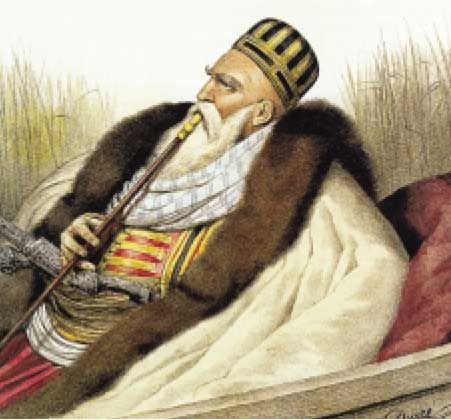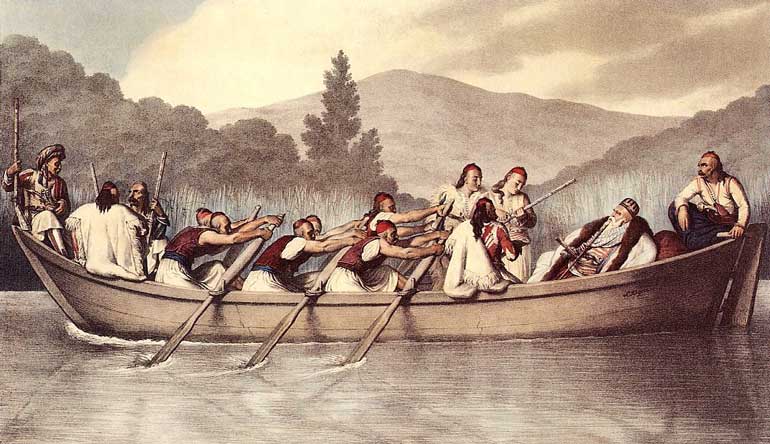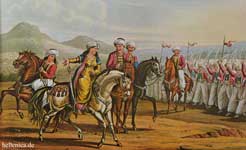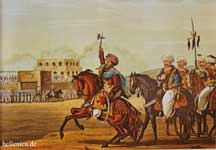.

Ali Pasha, Detail of a work of Louis Dupre 1819 (see below), in a boat in the Lake Vouthroton. In his belt (σελάχι , Selachi) he has two pistols and a knife.

Ali Pasha Tepelenë, commonly known as Ali Pasha, (1741 – January 24, 1822) was the military ruler (pasha) of a large area of the Ottoman Empire's European territories. Known as the Lion of Ioánnina (after his capital in the Greek town of Ioánnina), he achieved a notorious reputation as a cruel and bloodthirsty tyrant.
The rise of Ali Pasha
Ali was born into a powerful clan in the Albanian town of Tepelenë in 1744, where his father Veli was bey (leader). The family lost much of its political and material status while Ali was still a boy, and following the murder of his father in 1758 his mother, Khamco, formed a band of brigands. Ali became a notorious brigand leader and attracted the attention of the Turkish authorities. He aided the pasha of Negroponte (Euboea) in putting down a rebellion at Shkodër. In 1768 he married the daughter of the wealthy pasha of Delvino, with whom he entered an alliance.
His rise through Ottoman ranks continued with his appointment as lieutenant to the pasha of Rumelia. In 1787 he was awarded the pashaluk of Trikala in reward for his support for the sultan's war against Austria. This was not enough to satisfy his ambitions; shortly afterwards, he seized control of Ioánnina, which remained his power base for the next 33 years. He took advantage of a weak Ottoman government to expand his territory still further until he gained control of most of Albania, western Greece and the Peloponnese.
Ali Pasha as ruler
Ali's policy as ruler of Ioánnina was governed by little more than simple expediency; he operated as a semi-independent despot and allied himself with whomever offered the most advantage at the time. In order to gain a seaport on the Albanian coast Ali formed an alliance with Napoleon I of France. After Napoleon was defeated in Egypt, Ali switched sides and allied with the United Kingdom in 1814. His machinations were permitted by the Ottoman government in Constantinople for a mixture of expediency - it was deemed better to have Ali as a semi-ally than as an enemy - and weakness, as the central government did not have enough strength to oust him at that time.
The poet Byron visited Ali's court in Ioánnina in 1809 and recorded the encounter in his work Childe Roland. He evidently had mixed feelings about the despot, noting the splendour of Ali's court and the Greek cultural revival that he had encouraged in Ioánnina, which Byron described as being "superior in wealth, refinement and learning" to any other Greek town. In a letter to his mother, however, Byron deplored Ali's cruelty: "His Highness is a remorseless tyrant, guilty of the most horrible cruelties, very brave, so good a general that they call him the Mahometan Buonaparte ... but as barbarous as he is successful, roasting rebels, etc, etc." [1]
The capricious cruelties inflicted by Ali Pasha on his subjects became notorious throughout the region. Forty years after the inhabitants of Gardiki, Albania had wronged his mother, Ali wrought revenge by having 739 male descendants of the original offenders murdered. In 1801, he attempted to rape the mistress of his eldest son, but was thwarted; his revenge was to have the girl and seventeen of her companions bound, gagged and thrown alive into Lake Pamvotis. The incident is still remembered in local folk songs. In 1808, he captured one of his most renowned opponents, the Greek klepht Katsandonis. The unfortunate man was executed in public by having his bones broken with a sledgehammer.
The downfall of Ali Pasha
In 1820, Ali ordered the assassination of a political opponent in Constantinople. The reformist Sultan Mahmud II, who sought to restore the authority of the Sublime Porte, took this opportunity to move against Ali by ordering his deposition. Ali refused to resign his official posts and put up a formidable resistance to Ottoman troop movements. In January 1822, however, Ottoman agents assassinated Ali Pasha and sent his head to Constantinople.
The story of Ali Pasha's downfall was fictionalized in The Count of Monte Cristo, by Alexandre Dumas. In this famous novel, the daughter of Ali Pasha becomes a slave of the Count and helps him take revenge on the man who betrayed her father.
The scene of Ali's death, the monastery of Pandelimonos on an island in Lake Pamvotis, is today a popular tourist attraction. The hole made by the bullet which killed him can still be seen, and the monastery has a museum dedicated to the tyrant, which includes a number of his personal possessions.

References
- "Ali Pasa Tepelenë." Encyclopædia Britannica (2005)
- "Ali Pasha (1744? – 1822)". The Columbia Encyclopedia (2004).
- Rough Guide to Greece, Ellingham et al (2000)
Books
- Ibrahim Manzour Effendi, Mémoires sur le Grèce et l'Albanie pendant le gouvernement d'ali Pacha, (Paris, 1827)
- Pencker, Die Sulioten und ihre Kriege mit Ali Pascha von Janina, (Breslau, 1834)
- Davenport, The Life of Ali Pasha, (London, 1837)
- Brøndsted, Peter Oluf, Interviews with Ali Pacha. Edited by Jacob Isager, (Athens, 1998)

